
Closing deals is no longer about luck — it’s about having a clear, structured process that guides every lead from initial interest to final purchase. That process is called a sales cycle and mastering it is essential for any business looking to thrive.
If you’ve heard of the sales cycle but aren’t fully sure what it involves or how to optimise it, this article is for you. We’ll break down the key stages and provide actionable insights to streamline your process, helping you close more deals with less effort.
A sales cycle is a list of stages through which a lead or a prospect goes through in their buying journey. Let’s say you’re a lead or a prospect and you want to buy a laptop. Do you buy the first laptop you see?
No. You browse through plenty of options, compare features, pricing, it hardware procurement, quality of after sales support, etc., before arriving at a decision.
So you’ve gone from confused to curious to interested to finally buying the laptop of your dreams. Now all this is happening from your perspective, i.e., the buyer. From a salesperson’s perspective, this is called a sales cycle: A prospect shows interest in your product, gets qualified, then is shown ads on different platforms to further nurture them until they either drop off or make the purchase.
A structured sales cycle isn’t just a nice-to-have — it’s what separates successful sales teams from those that struggle. Without a clear process, leads slip through the cracks, follow-ups get missed and deals take longer than necessary to close. A well-defined sales cycle ensures every prospect is handled efficiently, leading to higher conversion rates and predictable revenue growth.
It also helps sales teams prioritise high-value leads, engage them with relevant content and address objections at the right time. Instead of wasting time on cold leads or chasing unqualified prospects, reps can focus on those who are actually ready to buy. This means faster deal closures, better resource allocation and ultimately, a more efficient sales process.
But the real game-changer? Scalability. When every team member follows the same structured approach, onboarding new hires becomes easier, sales efforts remain aligned and optimisations can be made based on real data — not guesswork. In short, mastering the sales cycle isn’t just about selling more; it’s about selling smarter. Now, let’s break down its key stages and see how to optimise each one.
Different businesses have varied sales cycle stages and sales processes. But the following seven stages are there in every sales cycle, no matter the industry or audience (B2B, B2C, C2C):
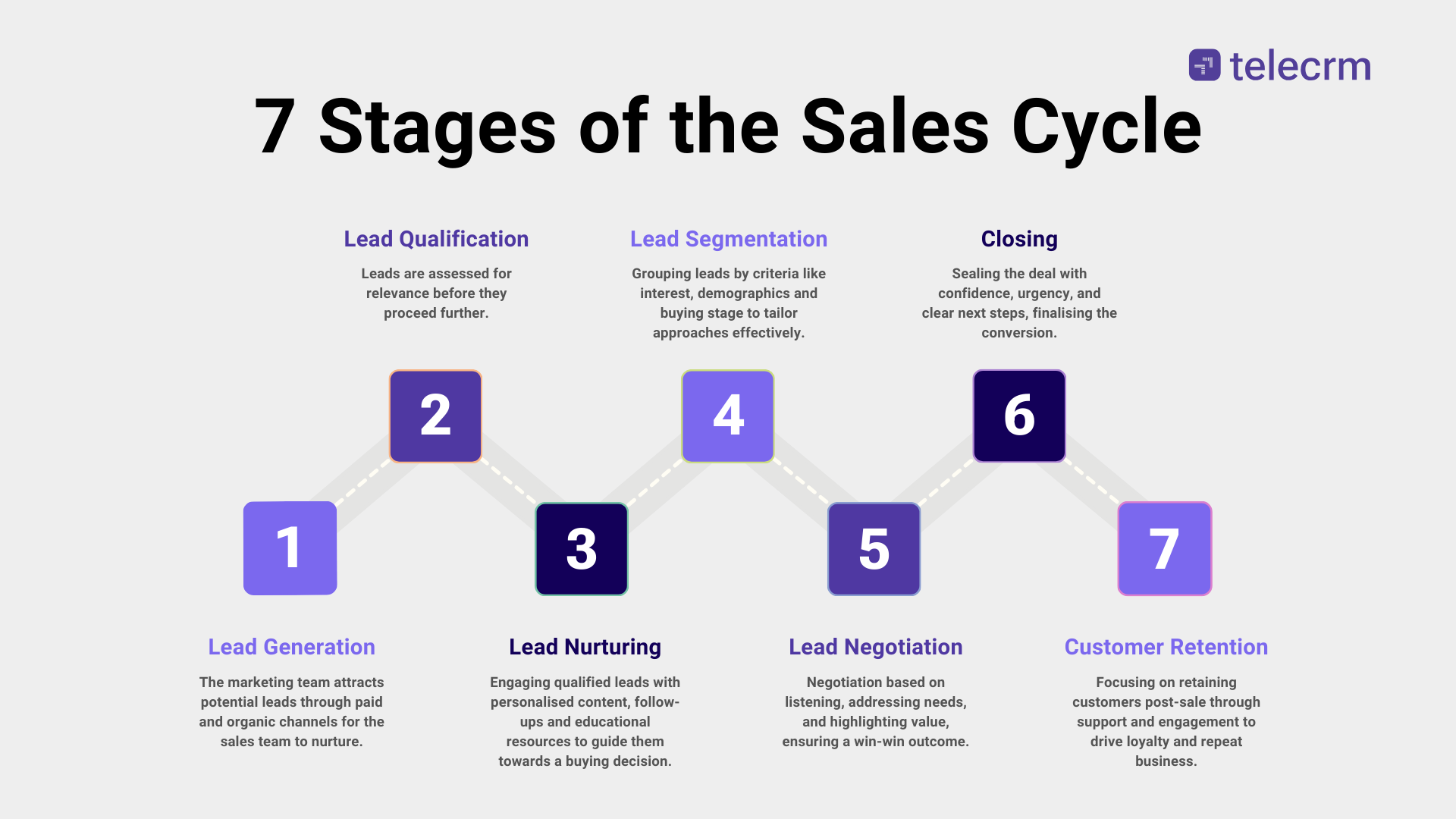
The first stage in any sales cycle is to generate the lead. It’s basically the job of the marketing team to generate relevant leads that the sales team can nurture and sell. The marketing team can generate leads in two ways:
Through paid mediums such as Google Ads, Facebook Ads, social media collaboration, influencer marketing, lead-generation tools
Through organic means including e-books, landing pages, blogs, etc.

A sales rep cannot simply start calling a lead from the get-go, because what if the lead turns out to be not as relevant as anticipated?
If the lead does turn out to be irrelevant, the agent will just waste their time pursuing that lead!
So a lead needs to be qualified before s/he moves down the sales funnel and it involves two steps:
Marketing qualified leads (MQL): At the top of the sales cycle, it’s the marketing team’s responsibility to place parameters to discard irrelevant leads the moment they are generated. For example, if a lead wants to download an e-book from a website, they’ll have to fill out a form embedded on the web page containing questions such as “Why do you need this e-book?” “What’s your profession?” “Is our product relevant for you?” — along with sharing their phone numbers and email addresses.
So now we have a lead that’s both relevant and is in need of our product or service.
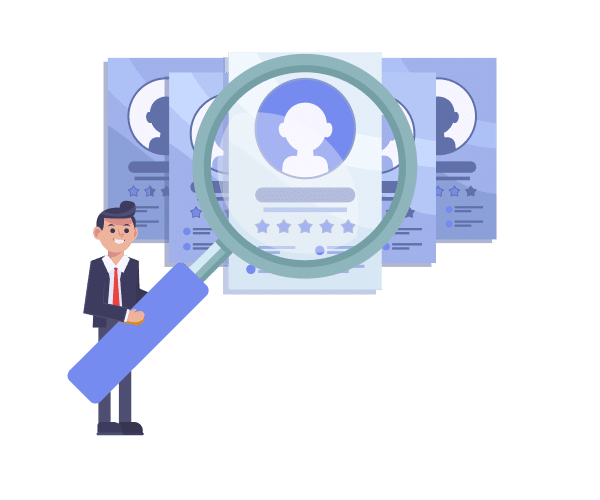
Sales qualified leads (SQL): Not all leads are the same. While most are not exactly interested but fill out the form anyway because they like the idea of getting something (e-book, white paper) for free, a few turn out to be high ticket size leads that are actually seriously considering buying the product!
So now the sales rep has to jump in and figure out:
Why has the lead filled out the form?
Are they relevant to our product or service?
If yes, then what problems are they exactly facing that our product can solve?
What’s their ticket size?
This is found out by interacting with the lead, mostly through discovery calls initiated by the sales reps themselves.
Once a lead has been qualified as an SQL, it doesn’t mean they’re ready to make a purchase right away. In fact, most leads need further engagement before they’re willing to buy. This is where lead nurturing comes in. The idea is to keep the lead interested, engaged and informed while gradually guiding them towards making a purchase decision.
A major part of nurturing is done by sales reps over phone calls. While some leads may be convinced to make a purchase after a few touchpoints, other not-so-interested leads need to be nurtured further.
How?
Personalised content: Sending targeted content that addresses the lead’s specific interests or pain points. For instance, if a lead is interested in getting a CRM software because they struggle with managing customer interactions, you could share blog posts, case studies or e-books that show how your CRM can solve this exact problem.
Follow-ups: Timely and relevant follow-ups are crucial. You could send an email or a WhatsApp message thanking them for downloading an e-book and follow up with more content that aligns with their needs. Make sure the tone is conversational and helpful rather than pushy.
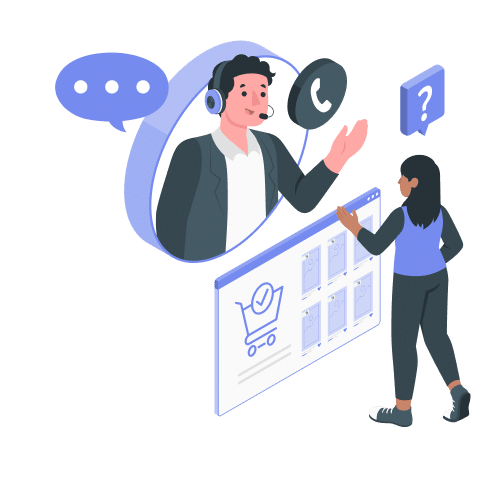
Educational webinars or product demos: If a lead has shown interest in your product but isn’t ready to buy, inviting them to a webinar or a demo can help answer their questions and clear doubts. This interaction can also allow your sales team to understand the lead’s specific needs better.
Automated drip campaigns: Use WhatsApp marketing automation to send a series of messages over time. These messages could range from educational content to customer testimonials and special offers. The goal is to keep your brand top-of-mind without overwhelming the lead.
Personalisation is key to selling a product or service. You can’t approach all the leads in the exact same manner because they all have different needs, budgets and varied levels of interest in your product or service.
So, firstly, you’ll have to segment them first based on the following criteria:
Level of interest: Understanding a lead’s engagement pattern helps you tailor your approach, ensuring you don’t overwhelm those who need more nurturing or miss out on hot prospects who’re ready to buy
Demographics: Segmenting by demographics allows you to customise messaging for different industries and locations
Buying stage: Identifying leads as ‘cold’ (early-stage), ‘warm’ (interested) or ‘hot’ (ready to buy) helps sales reps prioritise outreach efforts
Ticket size: Knowing the potential deal size ensures you allocate resources appropriately, focusing more effort on high-value leads that can offer a bigger return

Once you’ve segmented your leads and nurtured them through the funnel, the next critical step is negotiation. This is where most deals are either won or lost. It’s not just about offering the best price; it’s about understanding the lead’s needs, addressing their concerns and finding common ground that benefits both parties.

Here’s how you can navigate this phase effectively:
Listen more than you speak: The key to successful negotiation is understanding the prospect’s pain points, budget constraints and decision-making criteria. Listening closely allows you to frame your offer in a way that directly addresses their needs.
Be flexible, but firm: While you should be open to adjusting certain terms (like payment plans or additional features), stay firm on the value your product brings. Avoid excessive discounts that might diminish your product’s perceived worth.
Highlight value over price: If a lead pushes back on price, refocus the conversation on the value your product or service delivers. Show them how your solution will solve their problem, save time/resources and/or drive revenue. Case studies and testimonials can be powerful tools here.
Once the negotiation is underway, timely follow-ups become crucial. Most leads won’t make a decision after just one conversation, so consistent and thoughtful follow-ups are key to keeping them engaged:
Post-meeting recap: After every call or meeting, send a summary of what was discussed, including the next steps. This keeps everything clear and maintains momentum.
Timing is everything: Follow up regularly, but avoid being pushy. Space your follow-ups based on what stage of the journey the prospect is at — more frequent for ‘hot’ leads, not as frequent for those labelled ‘warm’ or ‘cold’.
Provide additional value: Each follow-up should offer something new, whether it’s answering a lingering question, sharing a helpful resource or offering a time-sensitive incentive.
Closing is the most crucial phase of the sales process, where all your efforts culminate in a final decision. This is the moment when your lead either becomes a customer or walks away for good. Mastering this step requires confidence, clarity and a focus on value.
Here’s how to ensure a smooth and successful deal closure:
Address objections head-on: Before a deal is sealed, prospects often raise last-minute concerns — about price, contract terms or specific product features. Be prepared to handle these objections calmly. For example, if pricing is an issue, offer flexible payment plans or highlight the long-term return on investment (ROI).
Create urgency: Sometimes, leads delay making decisions. You can create urgency without being pushy by offering limited-time discounts, exclusive deals or explaining how quickly they can start seeing benefits. For example your CTA could be phrased like this: “If you sign up by the end of this week, we’ll include a free training session” to spur action.
Clarify the next steps: At this stage, clarity is key. Clearly outline the steps for finalising the purchase, such as signing contracts, making payments or scheduling onboarding. A confused lead might hesitate, so ensure everything is straightforward.
Reaffirm value: Before the lead makes the final commitment, reinforce how your product or service solves their problems, improves efficiency or delivers ROI. Reiterate the key benefits they will gain from choosing your solution.
Ask for the sale: Don’t shy away from directly asking for their commitment. Whether it’s “Shall we go ahead and finalise the paperwork?” or “Can we confirm your subscription today?”, a clear call to action will go a long way in pushing the lead over the finish line.

Closing a sale is just the beginning of a long-term relationship with the customer. While getting new customers is important, retaining them is even more important and valuable. Studies show that acquiring a new customer can be five times more expensive than retaining an existing one. Plus, happy customers often lead to repeat business and referrals. So, after the sale is closed, customer retention should be your next focus.
Here’s how you can keep your customers happy and loyal:
Onboarding and support: The first few days after a sale are critical. Ensure your customer has a smooth onboarding experience by offering them training sessions, resources or a dedicated support contact. A customer who feels heard and cared for from day one is more likely to stick around.
Regular check-ins: Don’t wait for the customer to have issues. Proactively check in to see how they’re finding the product and whether they need any assistance. This shows that you care about their experience beyond the sale.
Share valuable resources: Keep your customers engaged by sharing tips, updates or new features that will help them get the most out of your product or service. For instance, share educational content like blog posts, invite them to exclusive webinars or offer loyalty discounts for upgrades or referrals.
Collect feedback: Asking for feedback not only helps you improve your product but also shows customers that their opinions matter. Conduct regular surveys or reach out personally to gather insights on how they’re using your product and what improvements they’d like to see.
Build relationships: Customer retention is more than just solving problems; it’s about building strong relationships. Whether it’s through personalised communication, extending special offers or even simple gestures like remembering important dates (such as their birthday) can strengthen the bond between you and the customer.
The sales cycle stages that we have mentioned are standard ones. There are multiple sub divisions based on the industry, the company, the type of sales (B2B, B2C), etc.
In fact, no two companies will have the exact same sales cycle stages because every business operates in a very unique manner. But how do you set up a custom sales cycle for your own business?
Follow these steps:
Here’s a quick video to help you setup your custom sales process:
Sales cycle isn’t a one-and-done process. You can’t just create a well-defined sales cycle and stop.
It needs constant optimisation.
Here are the best practices to ensure you have a fully functional sales cycle process:
To understand how well your sales cycle is performing, focus on crucial sales metrics such as:
Conversion rate: The percentage of leads that turn into paying customers. This helps you see how effectively leads are moving through the funnel.
Average sales cycle length: How long does it take to close a deal? Shortening this can improve efficiency and free up time to focus on new leads.
Lead-to-customer ratio: This indicates how many leads are needed to get a paying customer, helping you evaluate the quality of leads and the effectiveness of your nurturing process.
Customer acquisition cost (CAC): How much are you spending to acquire each customer? Lowering CAC while maintaining quality leads boosts profitability.
Your sales team is on the front lines and can offer valuable insights into what’s working and what isn’t. Regularly meet with them to discuss challenges, pain points and any patterns they notice in lead behaviour — what makes them lose interest or buy the product? Is there a problem in how sales reps approach prospects? or objections that the prospects might have concerning product quality or price.
Look at the stages where leads are falling out of the funnel. Are many leads dropping off after the discovery call? Or are they losing interest during the nurturing phase? Understanding where you lose potential customers can guide you in refining your approach.
Experiment with different techniques and strategies to see what works best. This could be trying new email templates, tweaking your follow-up timing or testing different sales pitches. Analyse the results to see which methods lead to better conversions.
Use CRM and sales automation tools to reduce time spent on repetitive tasks like sending follow-up emails or scheduling calls. Automation frees up your sales team to focus on high-priority tasks, like building relationships and closing deals.
Sales techniques evolve over time and ongoing training ensures your team members stay sharp. Invest in regular workshops or courses on negotiation, communication and product knowledge to keep your agents at the top of their game. To support your team, reliable tools and effective IT asset management are key, which ensures that your sales team has access to what they need to perform at their best.
You have created an amazing sales process, generate high-quality relevant leads and have a sales team that knows what it’s doing, but none of those things will make a difference if you manage your sales cycle manually or through messy spreadsheets. Because…
How do you track which lead is where in the sales cycle?
Without a centralised system, it’s nearly impossible to know at a glance who’s a hot lead, who needs nurturing and who’s ready to close.
How do you ensure timely follow-ups?
Manually setting reminders can easily lead to missed follow-ups or delayed responses, causing prospects to lose interest.
How do you avoid lead leakage?
As your list of leads grows, manually tracking each one makes it likely that some will fall through the cracks, costing you valuable business.
How do you prioritise high-value leads?
Without clear visibility into the sales funnel, your team might spend too much time on leads that are unlikely to convert, while overlooking prospects that are ready to buy.
How do you manage team collaboration?
With no shared platform, sales reps often work in silos, leading to communication gaps, duplicate efforts or inconsistent messaging to potential clients.
How do you access past conversations or customer details quickly?
Scattered data across spreadsheets or notes means your sales team wastes time searching for information, slowing down the sales process and reducing its effectiveness.
Worry not, there’s a one-stop solution to effective sales cycle management — a sales CRM, which can do the following:
Help you track all leads through the sales cycle in real time
Automate follow-ups so you never lose track of hot leads
Provide a centralised data hub to track and record every lead interaction in one place
Automate repetitive (manual) tasks like sending messages, updating lead statuses and even running bulk marketing campaigns
Help your team focus on high-value leads with dynamic lead segmentation
Generate customisable sales reports on important metrics like lead conversion rate, number of deals closed, sales numbers per sales rep and more!
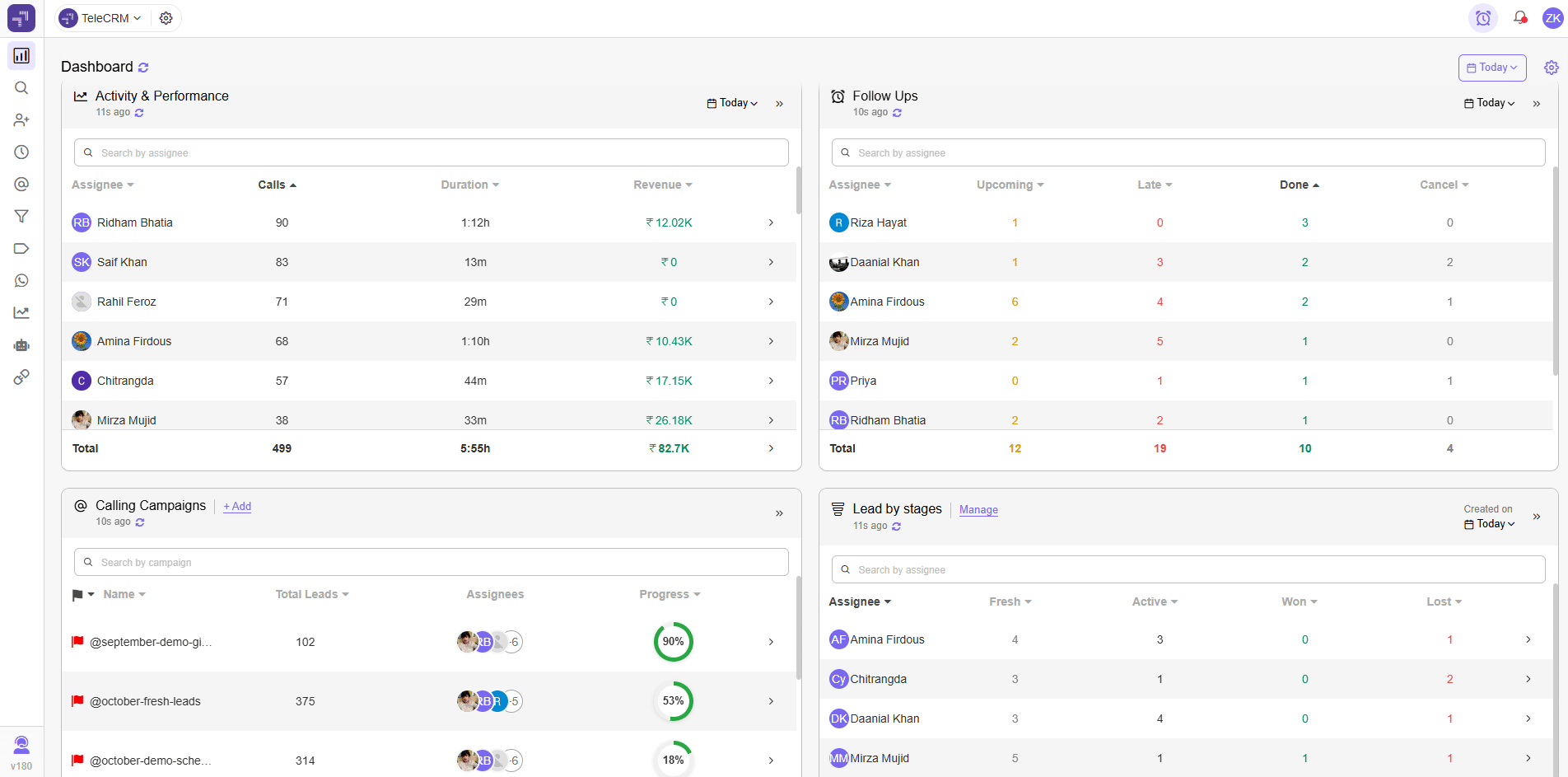
In this article, you’ve discovered just how crucial the sales cycle is in turning prospects into paying customers.
We’ve walked through the seven key stages, from generating and qualifying leads to nurturing, closing and retaining customers. You’ve also seen how using a CRM can make your life so much easier.
But if you’re not exactly sure whether you need a sales CRM, here’s a simple test that could help you decide whether you need one or not. If you answer yes to even three of the below items…
Make sales calls to close deals
Have a sales cycle that’s unique
Have a sales team that you need to manage and track
Use WhatsApp for lead communication
Lose leads because you can’t track them through the sales process
Are unable to keep track of your follow-ups
…you need a sales CRM.
A sales CRM like Telecrm with its telecalling and WhatsApp-based CRM features is designed for India-based sales teams with additional capabilities such as one-click dialer, automated lead management, customisable sales pipelines and much more.
Interested? Visit our page or book a demo to know more.


© Copyright 2025 Telecrm.in - All Rights Reserved • Privacy Policy • T&C
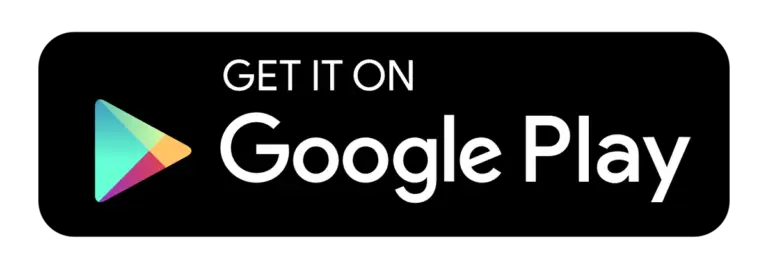

© Copyright 2025 Telecrm.in - All Rights Reserved • Privacy Policy • T&C